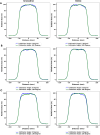Characteristics of the electron beam outside the applicator in an Elekta Versa HD Linac
- PMID: 40100569
- PMCID: PMC12209012
- DOI: 10.1007/s13246-025-01530-4
Characteristics of the electron beam outside the applicator in an Elekta Versa HD Linac
Abstract
Radiotherapy is an essential component of cancer treatment, but healthy tissues can be exposed to out-of-field doses, potentially causing adverse effects and secondary cancers. This study investigates peripheral doses outside the electron beam applicator in an Elekta Versa HD linear accelerator. Peripheral doses outside an electron applicator were measured using 6, 9, and 12 MeV beams at their respective maximum dose depths while maintaining a 100 cm source-to-surface distance. Measurements employed EBT3 films within Plastic Water DT phantoms. The influence of field size on penumbra width and peripheral doses were examined using various cutouts (6 × 6 cm², 10 × 10 cm², and a 5 cm diameter circle) within a 10 × 10 cm² applicator, with gantry and collimator angles set to 0 degrees. Additionally, the impact of collimator angles on penumbra width and peripheral doses was explored, enhancing the understanding of dose distribution. Measured profiles were also compared with those calculated using Monaco treatment planning system. Findings showed that both penumbra width and peripheral dose values increased with energy across different field sizes and collimator angles. Root Mean Square Deviation (RMSD) analysis indicated deviations of 1.8 mm for penumbra and 1.1% for peripheral doses between measured profiles and Treatment Planning System (TPS) predictions for all field sizes. Peripheral doses remained below 5% of the maximum dose at distances ranging from 10 to 15 mm away from the field edges, indicating acceptable tolerance levels (ICRU report 24). However, further dose reduction may be possible with additional shielding to keep doses as low as reasonably achievable. This study highlights the critical importance of considering peripheral doses in radiotherapy, emphasizing the need to evaluate the impact on healthy tissues outside the primary treatment area to ensure patient safety and mitigate long-term treatment-related side effects. The findings underscore the necessity of implementing appropriate measures to minimize peripheral doses.
Keywords: Applicator; Electron therapy; Elekta versa HD; Linac; Out-of-field; Peripheral dose.
© 2025. The Author(s).
Conflict of interest statement
Declarations. Ethical approval and consent to participate: Not applicable. Consent for publication: Not applicable. Conflict of interest: The author(s) declared no potential conflicts of interest with respect to the research, authorship, and/or publication of this article.
Figures











Similar articles
-
Dosimetric investigation of small fields in radiotherapy measurements using Monte Carlo simulations, CC04 ionization chamber, and razor diode.Phys Eng Sci Med. 2025 Jun;48(2):813-825. doi: 10.1007/s13246-025-01546-w. Epub 2025 Jun 16. Phys Eng Sci Med. 2025. PMID: 40522570 Free PMC article.
-
Entry skin dose reduction in an inline MRI-linac using an electron contamination deflector coupled with a helium volume.Med Phys. 2025 Jul;52(7):e17923. doi: 10.1002/mp.17923. Med Phys. 2025. PMID: 40665620 Free PMC article.
-
Dosimetric accuracy of low dose rate volumetric modulated arc therapy delivery in an Elekta Versa HD linear accelerator for pulsed low dose rate treatment of recurrent high-grade glioma using Monaco planning system: Low dose rate VMAT-based PLDR in Elekta Linac.J Appl Clin Med Phys. 2025 Sep;26(9):e70253. doi: 10.1002/acm2.70253. J Appl Clin Med Phys. 2025. PMID: 40903817 Free PMC article.
-
Peripheral Doses Beyond Electron Applicators in Conventional C-Arm Linear Accelerators: A Systematic Literature Review.Technol Cancer Res Treat. 2024 Jan-Dec;23:15330338241239144. doi: 10.1177/15330338241239144. Technol Cancer Res Treat. 2024. PMID: 38515394 Free PMC article.
-
Sertindole for schizophrenia.Cochrane Database Syst Rev. 2005 Jul 20;2005(3):CD001715. doi: 10.1002/14651858.CD001715.pub2. Cochrane Database Syst Rev. 2005. PMID: 16034864 Free PMC article.
References
-
- ICRP, Stewart FA, Akleyev AV et al (2012) ICRP publication 118: ICRP statement on tissue reactions and early and late effects of radiation in normal tissues and organs–threshold doses for tissue reactions in a radiation protection context. Ann ICRP 41:1–322 - PubMed
-
- Khan FM, Gibbons JP (2014) Khan’s the physics of radiation therapy. 5th Edition ed. Philadelphia: Lippincott Williams & Wilkins
-
- Podgoršak EB (2006) Radiation physics for medical physicists. Biological and medical physics, biomedical engineering. Springer, Berlin;
MeSH terms
LinkOut - more resources
Full Text Sources
